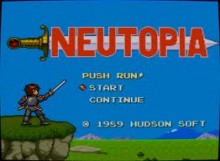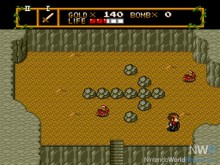Empty Elegy: Neutopia
Posted on April 07 2013 by Bastian
 Zelda clones. They get a bad rap. Sometimes deservedly so. As we discussed in our post last week, sometimes clones are made out of sheer love for our favorite series. Other times they are simply made to cash in on Nintendo’s ideas.
Zelda clones. They get a bad rap. Sometimes deservedly so. As we discussed in our post last week, sometimes clones are made out of sheer love for our favorite series. Other times they are simply made to cash in on Nintendo’s ideas.
One such clone, Neutopia, is the latter, and is one of the very first (but not the first) Zelda clones made. It shares so much in common with the original Legend of Zelda that it is shocking the creators were not faced with a lawsuit.
Jump inside to find out about the similarities and differences!
 The very first time I heard the phrase “Zelda clone” was in reference to Neutopia. I didn’t understand what a “clone” was back then. I thought it was simply a hack of a game to create new dungeons or areas or something (similar to the Link to the Past hack Parallel Worlds). It was only a couple years later when I actually saw a screen shot of Neutopia that I finally understood: this was a brand new game, but built to copy all the core aspects of Zelda without actually copying the exact graphics and terminology. So instead of defeating a boss at the end of an underground dungeon and receiving a Heart Container… you defeat a boss at the end of a labyrinth and receive a Life Stone.
The very first time I heard the phrase “Zelda clone” was in reference to Neutopia. I didn’t understand what a “clone” was back then. I thought it was simply a hack of a game to create new dungeons or areas or something (similar to the Link to the Past hack Parallel Worlds). It was only a couple years later when I actually saw a screen shot of Neutopia that I finally understood: this was a brand new game, but built to copy all the core aspects of Zelda without actually copying the exact graphics and terminology. So instead of defeating a boss at the end of an underground dungeon and receiving a Heart Container… you defeat a boss at the end of a labyrinth and receive a Life Stone.
 Neutopia was developed by Hudson Soft in 1989 for the TurboGrafx-16. Nintendo still had not yet released their Super Nintendo (or Super Famicom in Japan) and were still entrenched in development for A Link to the Past. TurboGrafx-16 clearly wanted to get in on the Zelda action and Hudson soft was more than happy to deliver. At this time “Zelda” simply meant the original Legend of Zelda and The Adventure of Link. The consensus–even back then–was that Zelda II was the weaker of the two initial games; it did not provide the style of gameplay that everyone fell in love with in the original Legend of Zelda. Perhaps this is what motivated Hudson Soft. Maybe they looked at Zelda II and said: “This isn’t what people want, we’ll give people the Zelda sequel they were hoping for.” That’s what I’d like to think. I’d hate to think that Hudson Soft, themselves inventors of many fantastic games back in the day, would opt to rip off another developer simply for the cash. My point being: they focused on cloning “Zelda” as it only specifically existed in that first game.
Neutopia was developed by Hudson Soft in 1989 for the TurboGrafx-16. Nintendo still had not yet released their Super Nintendo (or Super Famicom in Japan) and were still entrenched in development for A Link to the Past. TurboGrafx-16 clearly wanted to get in on the Zelda action and Hudson soft was more than happy to deliver. At this time “Zelda” simply meant the original Legend of Zelda and The Adventure of Link. The consensus–even back then–was that Zelda II was the weaker of the two initial games; it did not provide the style of gameplay that everyone fell in love with in the original Legend of Zelda. Perhaps this is what motivated Hudson Soft. Maybe they looked at Zelda II and said: “This isn’t what people want, we’ll give people the Zelda sequel they were hoping for.” That’s what I’d like to think. I’d hate to think that Hudson Soft, themselves inventors of many fantastic games back in the day, would opt to rip off another developer simply for the cash. My point being: they focused on cloning “Zelda” as it only specifically existed in that first game.
 Just how deliberately? Pretty deliberately. Everything from bombing mountain walls for discovering citizens who are happy to give you Life Stones or money or upgrades to your bomb bag. Even stylistic choices like the basic layout of each overworld screen. On the overworld you can use your fire rod to light bushes on fire and possibly reveal hidden staircases. Or you can push large rocks to uncover hidden staircases.
Just how deliberately? Pretty deliberately. Everything from bombing mountain walls for discovering citizens who are happy to give you Life Stones or money or upgrades to your bomb bag. Even stylistic choices like the basic layout of each overworld screen. On the overworld you can use your fire rod to light bushes on fire and possibly reveal hidden staircases. Or you can push large rocks to uncover hidden staircases.
 The dungeons themselves also borrow heavily from the first Zelda. You push blocks to open shuttered doors after you defeat all the enemies in the room, you have a map sub-menu which looks suspiciously like the original Legend of Zelda‘s, you must find and defeat a boss at the end and then proceed to the next room which houses one of the many mystical artifacts (orbs, rather than Triforce pieces) which when collected allow you to enter the final boss’ dungeon.
The dungeons themselves also borrow heavily from the first Zelda. You push blocks to open shuttered doors after you defeat all the enemies in the room, you have a map sub-menu which looks suspiciously like the original Legend of Zelda‘s, you must find and defeat a boss at the end and then proceed to the next room which houses one of the many mystical artifacts (orbs, rather than Triforce pieces) which when collected allow you to enter the final boss’ dungeon.
 With Neutopia being so similar, does it actually offer anything new? Well, frankly, even if all it offered was a new overworld and new dungeons, that likely would have been enough to sate the hunger people had back then for “more Zelda”… especially “more Zelda on the console I have”. But Hudson Soft actually tried to improve Zelda, and in some ways they succeeded. They do provide a compass, but instead of finding a new compass in each dungeon to point to the orb you need to collect, they give you one compass which you use on the overworld; it points to the direction of the entrance of the next dungeon you need to complete. I think this was done due to the fact that one of the most difficult aspects of The Legend of Zelda was just finding each dungeon. A welcome change! They were also clearly enamored with the fun the Magic Rod provided when coupled with the Magic Book (it then acts as a Fire Rod, for those who don’t remember) because they give this same item to you right in the beginning and continuously upgrade it to become more and more powerful as you gain more and more Life Stones. The story is also slightly more detailed. And the game seems to want to provide answers to some of the strange quirks of that first Zelda game–for instance: just why are there people living in caves which you have to bomb entrances into… Neutopia gives you a plausible answer.
With Neutopia being so similar, does it actually offer anything new? Well, frankly, even if all it offered was a new overworld and new dungeons, that likely would have been enough to sate the hunger people had back then for “more Zelda”… especially “more Zelda on the console I have”. But Hudson Soft actually tried to improve Zelda, and in some ways they succeeded. They do provide a compass, but instead of finding a new compass in each dungeon to point to the orb you need to collect, they give you one compass which you use on the overworld; it points to the direction of the entrance of the next dungeon you need to complete. I think this was done due to the fact that one of the most difficult aspects of The Legend of Zelda was just finding each dungeon. A welcome change! They were also clearly enamored with the fun the Magic Rod provided when coupled with the Magic Book (it then acts as a Fire Rod, for those who don’t remember) because they give this same item to you right in the beginning and continuously upgrade it to become more and more powerful as you gain more and more Life Stones. The story is also slightly more detailed. And the game seems to want to provide answers to some of the strange quirks of that first Zelda game–for instance: just why are there people living in caves which you have to bomb entrances into… Neutopia gives you a plausible answer.
And then there’s the whole 16-bit aspect. It certainly is a very beautiful game, especially when compared to The Legend of Zelda and The Adventure of Link. Of course, A Link to the Past would eventually come along and blow Neutopia out of the water both visually, but especially audio-wise as well. This is because while the TurboGrafx-16 was a 16-bit console graphically (hence the name) it was not so audio-wise, it used two 8-bit audio chips instead of a true 16-bit audio chip. That would be like taping two Game Boy Advances together and calling it the same as a DS… not quite the same thing.
So, would I recommend this game? Well, I enjoyed it, but that’s because I really loved the original Legend of Zelda, and playing Neutopia was like playing that first Zelda game in an alternate reality. Really, that’s the only reason to play Neutopia: you loved the original Legend of Zelda and want more of that exact same game. Also, it’s worth mentioning that Neutopia was so well-received that they made one sequel which takes place about a decade and a half later. It’s basically more of the same with very few changes in gameplay and style.
Have you played Neutopia? Let me know what you thought of it in the comments and which Zelda clone you think I should cover next!




